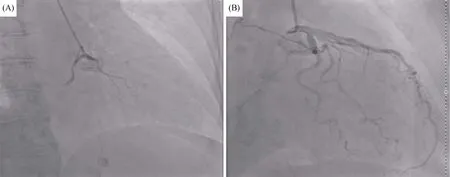Myocardial infarction with ST-segment elevation in old patient with history of takotsubo syndrome
2018-08-09MonikaBudnikJanuszKochanowskiRadoslawPiatkowskiRobertKowalikJanuszKochmanGrzegorzOpolski
Monika Budnik, Janusz Kochanowski, Radoslaw Piatkowski, Robert Kowalik, Janusz Kochman,Grzegorz Opolski
1First Chair and Department of Cardiology, Medical University of Warsaw, 1a Banacha Street, 02–097 Warsaw, Poland
2Department of Noninvasive Cardiology and Hypertension, Central Clinical Hospital of the Ministry of the Interior and Administration, Wołoska 137, 02–507 Warsaw, Poland
Keywords: Myocardial infarction; Recurrence of disease; Takotsubo syndrome
Takotsubo syndrome (TTS) is a rare condition that affects mainly aging women. TTS was first reported in 1990r and is characterized by clinical symptoms, ECG changes and regional wall motion abnormalities without changes in the coronary arteries. However, some reports admit the possibility of coexistence of TTS and coronary artery disease.We present a patient who had not had any changes in coronary arteries until four years later when she had myocardial infarction associated with right coronary artery narrowing,despite the fact that the risk factors of coronary heart disease were closely monitored.
A 76-year-old woman was admitted to the Department of Cardiology because of a 20-minute resting chest pain which occurred during work and which had not been preceded by emotional or physical stress. The ECG showed a ST-segment elevation in the inferior leads.
Four years ago, she was admitted to our clinic with a suspected acute coronary syndrome (ACS). The pain was similar to her current symptoms and was not associated with any stress factor. In the ECG T waves inversion in the anterior and lateral leads was observed. There was also a slight increase in the markers of myocardial necrosis (TnI max 0,99 ng/mL), typical for TTS.[1]The echocardiography revealed wall motion abnormalities, namely apex and apical segments of left ventricle akinesia, middle segments of anterior and lateral wall hypokinesia. The coronary angiography revealed no significant changes in the coronary arteries.The ventriculography revealed apical, anterolateral and diaphragmatic segment akinesia (Figure 1).
After a week there was no contractility impairment in Echo, with ejection fraction (EF) at 65% (Figure 1). Clinical findings and additional studies allowed to diagnose TTS.[2]During ambulatory follow-up, patient (pt) was actively performing her work duties. She did not have angina and did not show any evidence of heart failure. The ECG had completely normalized by the time of her release from hospital,where she was treated with beta-adrenolytic, angiotensinconverting enzyme (ACE) inhibitor, statin and aspirin. Her blood pressure and cholesterol level too were stabilized.
Under the conditions where all possible risk factors were successfully monitored, the lack of significant changes in the coronary arteries four years before her current hospitalization and the clinical symptoms similar to those present during her first episode had lead us to suspect the recurrence of takotsubo cardiomyopathy which occurs in about 5% of cases.[3]However, coronary angiography revealed the presence of critical stenosis in the segment 2 of the right coronary artery (RCA) (Figure 2).
Immediately after the exam, the RCA angioplasty with everolimus eluting stent implantation was performed.Compared to the previous hospitalization, the troponin level at the current hospitalization was at 15,858 ng/mL. This confirms some researchers' assumption that if the troponin concentration is above 15 ng/mL, a tako tsubo cardiomyopathy diagnosis is unlikely.[4]
Echocardiography revealed basal and middle segment of inferior wall akinesia, as well as basal segment of the inter-ventricular septum akinesia. EF was at 49% (Figure 3).Subsequent ECG revealed an evolution of inferior wall myocardial infarction. Myocardial infarction (MI) was not complicated, and pt was discharged in a good general condition.

Figure 1. ECG and ventriculography performed at admission and ECG after seven days.

Figure 2. Coronary angiography performed at admission. (A): right coronary artery; (B): left coronary artery.
Most researchers believe that significant changes in the coronary arteries exclude the diagnosis of TTS. In the literature, some reports admit the possibility of coexistence of TTS and coronary artery disease (CAD). Patients with CAD,these reports claim, may develop TTS, but this does not occur frequently.[5]In the Japanese population, significant changes in the coronary arteries coexisted in 10% of TTS cases.[6]Similar observations were presented by Italian researchers, who claim that 9.6% of patients had at least one significant stenosis in the coronary arteries which do not supply the area with impaired contractility.[7]There are no reports on the incidence of MI after TTS. Of the 100 patients who underwent long- term follow-up only one had significant coronary lesions requiring coronary artery bypass grafting, but that took sixteen years following the TTS episode.[9]Our observation of 117 patients with TTS with a maximum follow-up of 8 years has not so far revealed another case of ACS after TTS. Our patient had not had any changes in RCA until 4 years later when she had MI associated with RCA narrowing, despite the fact that the risk factors of coronary heart disease were very closely monitored.It is believed that there are differences in the pathophysiology between chest pain in patients with TTS and those with ACS. These, however, may both have common underlying factors whose precise nature is still to be established.

Figure 3. ECG performed at adminssion (A), and after seven days (B).
CAD does not exclude the diagnosis of TTS. Although these two diseases have different pathophysiology they may coexist. Recurrence of takotsubo syndrome occurs in about 2% cases, however in case of chest pain myocardial infarction is still possible. As elderly patients, especially women often present atypical symptoms and chest pain may be wrong diagnosed, it is very important to maintain a high index of suspicion for acute MI even if symptoms and past medical history suggest alternative diagnosis.
杂志排行
Journal of Geriatric Cardiology的其它文章
- Heterogeneous genetic architecture by gender for precision medicine of cardiovascular disease
- Echocardiography in centenarians: characteristics, utility and follow-up
- Sphingosine 1 phosphate receptor-1 (S1PR1) signaling protects cardiac function by inhibiting cardiomyocyte autophagy
- Association between baseline platelet count and severe adverse outcomes following percutaneous coronary intervention
- Optimal timing of staged percutaneous coronary intervention in ST-segment elevation myocardial infarction patients with multivessel disease
- Predictors of long-term outcome in patients with biopsy proven inflammatory cardiomyopathy
